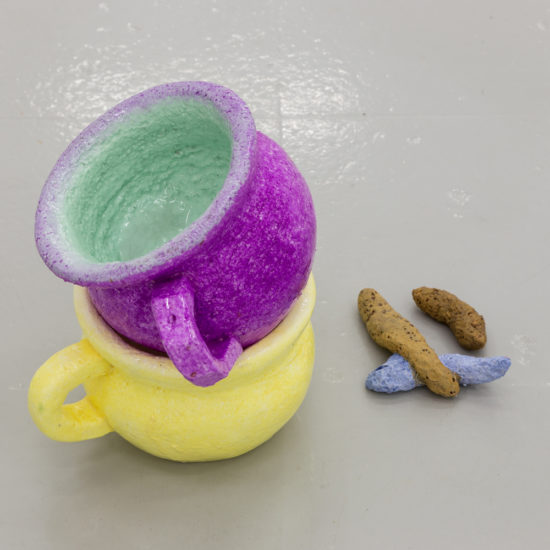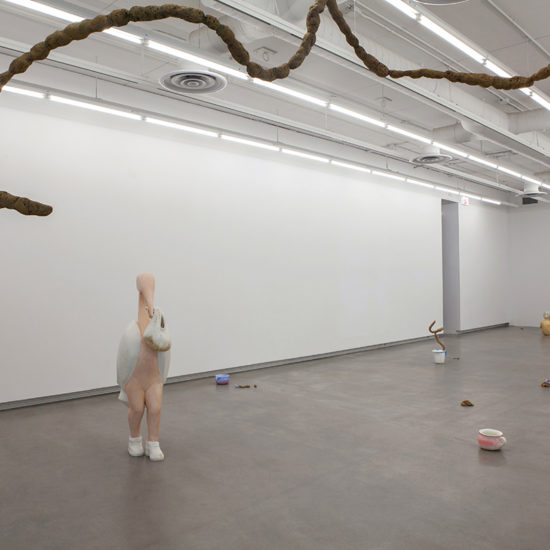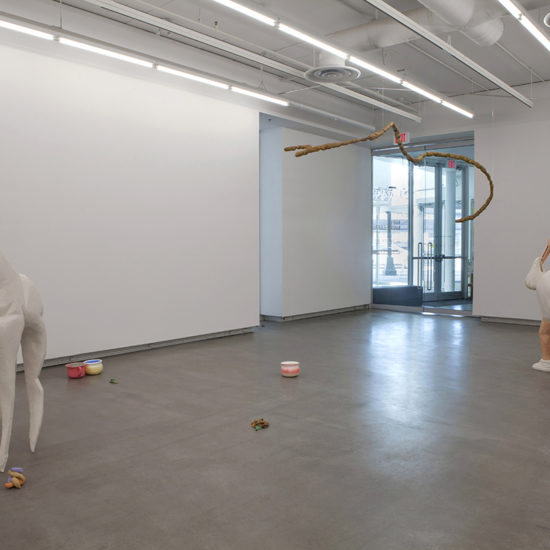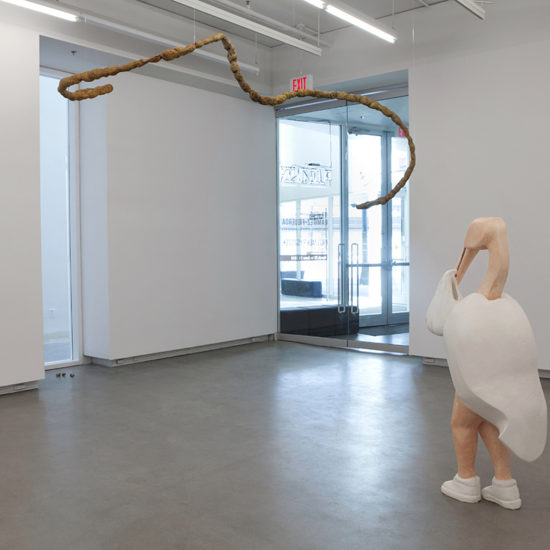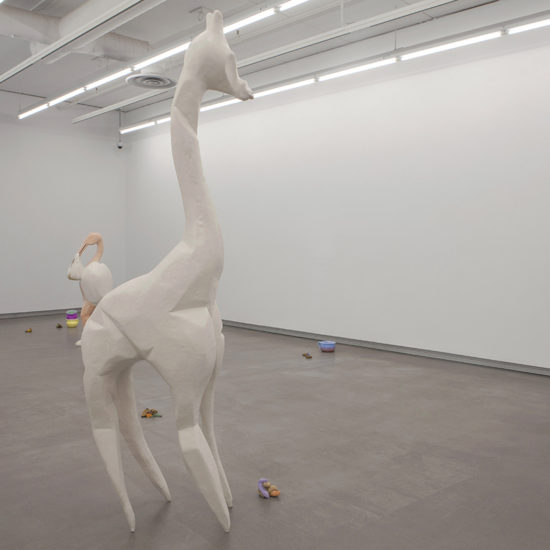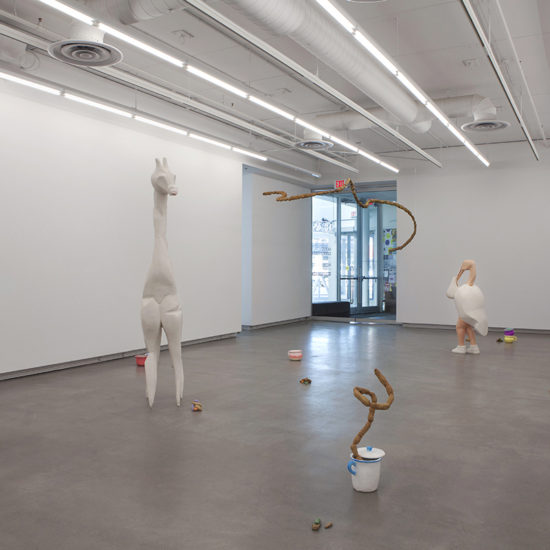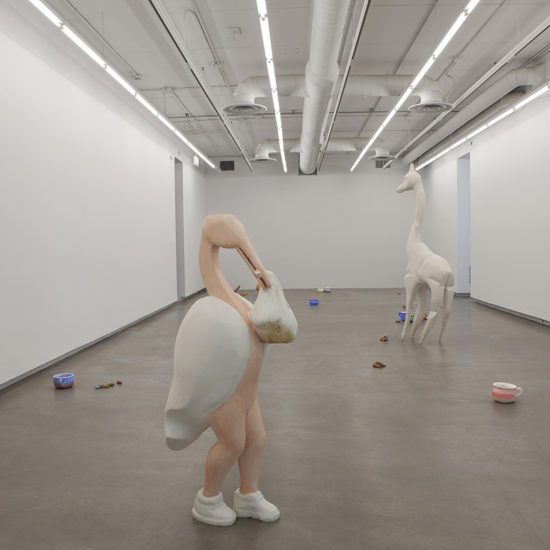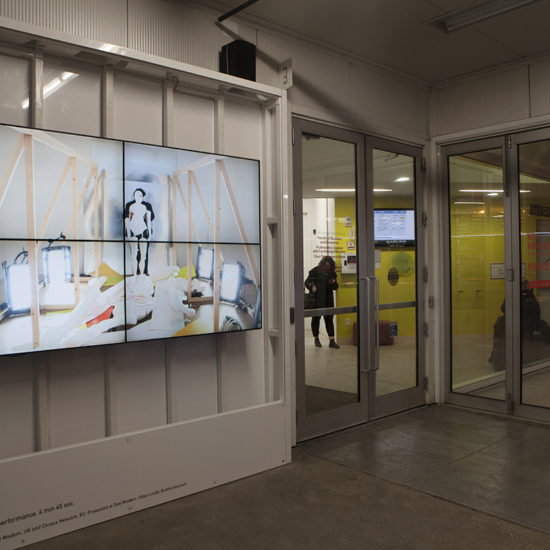Shit-Baby and the Crumpled Giraffe is a rare sculptural display of Naufus Ramírez-Figueroa’s characteristic penchant towards humor, abjection, and performance as he transforms bodily action into object form . For his solo exhibition at Plug In ICA, Ramirez-Figueroa immerses the viewer in a theatrical space where the fantastical meets a corporeal reality. He sets a stage through a series of sculptural forms painstakingly constructed out of Styrofoam, revealing an imaginary and infantile world.
Exploiting an interest in the function and training of the body that is most acutely encountered in childhood, for this presentation at Plug In ICA, Shit-Baby and the Crumpled Giraffe will be adapted from its recent incarnation at the Kunsthalle Lissabon in Portugal (Fall 2017). Invited into the exhibition through a scattering of objects , viewers encounter imperfect colored vessels arranged in careful clusters, and dispersed amidst small piles of “beautifully sculpted poo”. One deviant strand hovers serpent-like – fantastical and ominous, airborne amidst a human-sized giraffe; a sneaker-wearing pelican carrying a sack of feces; and a seated naked toddler. (Full curatorial essay below)
Naufus Ramírez Figueroa is a Guatemalan and Canadian artist. Working in sculpture, performance, video, installation and printmaking, Figueroa’s work is grounded in mechanisms and conditions of colonialism worldwide, with specific investment in Guatemalan history. Receiving ongoing support from Corpus (2015-present), Figueroa has engaged in a series of performances that he describes as an “attempt to exhaust my interest into the Guatemalan Civil War (1960-1990)”. The weight of his subjects is often tempered by a playful material sensibility, forays into childhood, dreams, fantasy and the complexity of embodiment. Figueroa holds a BFA from Emily Carr University, Vancouver with a specialization in media art, and an MFA from The School of the Art Institute of Chicago. His work has garnered international acclaim, with notable inclusions in Viva Arte Viva, 57th Venice Biennale 2017; Incerteza viva, 32nd São Paulo Biennale, 2016; Burning Down the House, 10th Gwangju Biennale, 2014 and in 2016, he was a resident artist at DAAD, in Berlin. He also has strong ties to Canada, where his work was featured on the cover of FUSE Magazine in 2013 and in 2018-19 Figueroa will present three major solo exhibitions in Canada, at Grunt Gallery, Vancouver; the Audain Gallery, Vancouver; and Plug In ICA, Winnipeg.
ASSOCIATED PROGRAMMING
Thursday, April 26 | 7pm
Screening: “Mimesis of Mimesis” and “Linnaeus in Tenebri” by Naufus Ramírez-Figueroa.
Date (TBD)
Respondent Series: Play As Radical Practice Toolkit with Alex Thorp, Education Curator, Serpentine Gallery London, UK
Wednesday, May 23 | 7pm
Respondent Series: Art City Talk
Sunday, June 10| 3pm
Interpreting [Interrupting] Youth screening and panel discussion
Postponed (New Date TBA)
Artist talk with Naufus Ramírez-Figueroa
GUIDED TOURS
Saturday, April 21 | 3pm
Curatorial Tour with Jenifer Papararo
Samedi, 5 mai | 15h
Visite guidée en française avec Janelle Tougas
Sábado, 19 de mayo | 15h
Visita guiada en español con Francesca Carella Arfinengo
Naufus Ramírez-Figueroa has been quoted as saying “At the end of the day, I am just making images.”i This generalized statement when isolated within the context of Ramírez-Figueroa’s performance and sculptural work alludes to both the artist’s intent and a process of making. Each action carried out or object made by the artist contributes to a larger picture or series of scenes that have personal and political referential points often alluding to the over 30 year civil war in his home country of Guatemala addressing the violence and unrest of a country that had his family flee to Mexico and then Canada.
This history is embedded into much of Ramírez-Figueroa’s production of images through an amalgamation of scripted actions and sculptural forms that often uses costuming to frame the body and prop-like objects to set it in motion. His recent work, El corazón del espantapájaros (Heart of the Scarecrow) (2015) is constructed around five characters from an oligarch to a religious leader or more common soldier pulled from a 1960s play by Guatemalan playwright Hugo Carrillo, for which Ramírez-Figueroa makes costumes, masks and props. He presents these theatrical devices in a cluster hanging in a circular formation waiting to be animated by actors in staged performances based on rewritten scripts of the original play. Ramírez-Figueroa’s work often references the history of experimental theatre in Guatemala known for its social critic and a blend of realistic elements intertwined with the magical, absurd and grotesque, and further combined with a poetic use of myth and folklore.ii
In the performance video Illusion of Matter (2015), which plays on a loop in Plug In’s breezeway, Ramírez-Figueroa cast himself in a central role, reminiscent of any one of Carrillo’s cast of characters. Ramírez-Figueroa often performs in his work, using his body as an object but also as a director who establishes action. In this performance video, the artist holds a white foam skeleton-like figure in front of him while he walks down a colourful corridor of yellows and oranges from which white oblong objects poke through. Once out of the picture frame, the artist gives direction to those holding the white objects to switch props and come out from behind the scenes waving their new objects, which have animal-like qualities, and seem to have their internal organs exposed. The viewer now sees that children have been puppeteering these objects – to whom the artist utters, “destroy” which the children do so using their props and hands to pull down the set.
Illusion of Matter seems a celebration, or maybe a spiritual ritual, or even the parade of a corrupt dictator; no matter, the scene is certainly a tale gone awry in the improvised chaos of children bringing the house down in a scripted act of defiance. The actions of these children who are clearly enjoying themselves as they rip the simple set apart are given the ability to control their actions. They gain this control through destruction. There is no pause here, where the child even though guided, intuitively takes action.
In Shit-Baby and the Crumpled Giraffe the main work in Ramírez-Figueroa’s exhibition at Plug In ICA, the artist taps into this child-like possibility, casting the child, here, an infant who is magically shitting, in a role that directs the scene. A cast of characters from a stork to a deformed giraffe sits amongst simple sculpted objects in an unfolding drama of subjugated memories. The interactions between the sculptural forms take place in a void – in the blank space of the white cube as if in a dream or foggy memory. The haze of early childhood memories is conjured through this blankness and embodied by the sculptural forms carved out of foam and painted brightly. This scene captures the spirit of childhood, illuminating infantile perceptions, not necessarily illustrating the wonderment of new experiences but instead the odd clarity of a child not yet swayed by or conformed into the shame of its bodily functions.
Shit-Baby and the Crumpled Giraffe is about the body, as is much of Naufus Ramírez-Figueroa’s work. Not a disenfranchised body but one that acts politically and rests in the personal. The term ‘the body’ is a loaded word in contemporary art, drawing references to performance art in the sixties where the body is a material to be used – the body as a tool and medium. The human form is material for Ramírez-Figueroa but it becomes a metaphorical prop to unravel histories of suppression that rest in the body.
Curated by Jenifer Papararo



